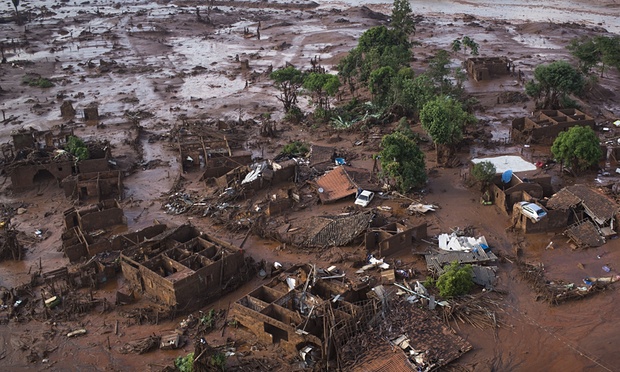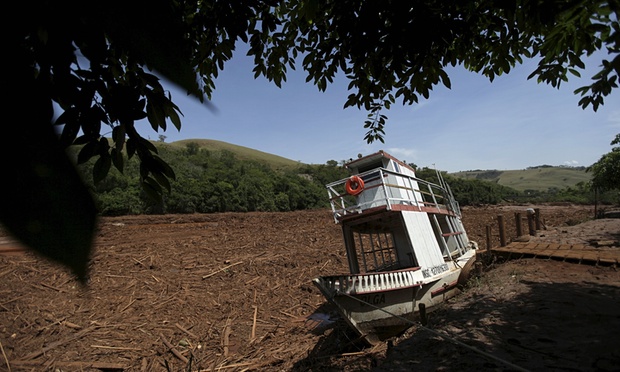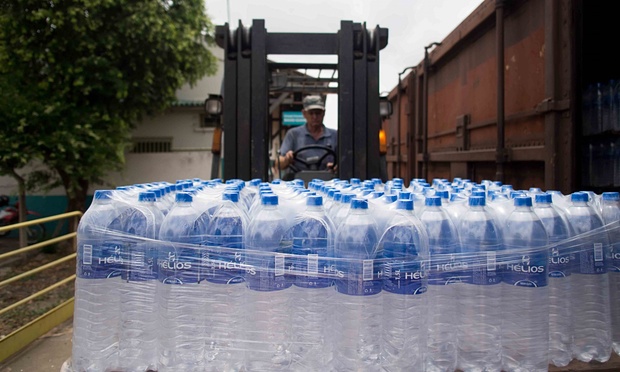Anger Rises as Brazilian Mine Disaster Threatens River and Sea with Toxic Mud
ENVIRONMENT, 23 Nov 2015
22 Nov 2015 – Conservationists and engineers battle to reduce the ecological fallout as mud and iron-ore residue from the BHP Billiton-Vale dam collapse flows down the Rio Doce to the Atlantic.

Homes lay in ruins after two dams burst, flooding the small town of Bento Rodrigues in Minas Gerais state, Brazil. Photograph: Felipe Dana/AP
Seven years ago, Luciana Cunha paid her first visit to the fishing village of Regência, in the Brazilian state of Espírito Santo, to surf the famous waves near the mouth of the Rio Doce.
She fell in love twice – with the place and her husband, Fabio Gama – and together they set up an eco-tourism business, renting out kayaks by day and offering guided tours to the nesting sites of marine turtles at night.
But after the brown tide of mud and iron-ore residue oozing down the Rio Doce from a mine 300 miles away reached the outskirts of Regência on its destructive journey to the Atlantic Ocean, the couple now wonder how they will cope. Bookings for what should be a busy summer season have shrunk to zero after the accident.
“I can’t imagine what life in the village will be like,” Gama said. “Whatever happens, the magic of the place is over.”
This weekend, 16 days after the collapse of the Fundão dam supporting the reservoir of the Samarco mine, the waters in the delicate ecosystem of the Rio Doce estuary began to turn brown.
A crowd gathered at the village’s wooden dock to watch. Behind a tape cordon, a group of technicians from Samarco, – a joint venture of the Brazilian mining company Vale and the Ango-Australian firm BHP Billiton – sat under a marquee staring at monitors.
To a small village with fewer than 2,000 residents, dependent on fishing, tourism and marine conservation, the arrival of the contaminated mud represents an existential threat.
“I have lived here all my life, and I never thought I would leave here,” said Bruna Cordeiro de Santos, a 29-year old teaching assistant. “Now I have started to think where are we going to go? What are we going to do?”

Scientists say sediment could alter the course of streams as they harden, reduce oxygen levels in the water and diminish the fertility of riverbanks and farmland. Photograph: Ricardo Moraes/Reuters
Local fishermen, contracted by Samarco to install protective barriers along a five-mile stretch of the riverbanks, lounged at the back of the crowd in distinctive bright orange jumpsuits.
Approached by the Guardian, they said they were not allowed to talk to the press.
Luciano Cabral, a biologist working for the municipal environmental department, said it was too early to tell if the fine mesh barriers, anchored to the riverbed and suspended by buoys, would work. But he was cautiously optimistic that the estuary would not be as badly affected as other parts of the river. “We believe that the mud is being diluted as it travels, and that the saltwater here will help in its dispersal,” he said.
On one of the sandbanks out to sea, three diggers were at work attempting to widen the mouth of the river.
“The best thing that can happen now is for the mud to flow out to sea as quickly as possible,” said Antonio de Padua Almeida, a biologist and head of the local Comboios nature reserve. “The mud will have much greater impact on the river than on the sea.”
According to the latest models used by the environmental agencies studying the flow, the mud plume is expected to disperse along the coast around six miles south of Regência, two miles north and 1.5 miles out to sea.
The area is rich in marine life, including humpback whales and La Plata dolphins, but Almeida’s greatest concern is for the endangered leatherback turtle. The beach is one of the only regular nesting grounds for the creature in Brazil.
“If the mud ends up on the beach, this could have a devastating effect on the population,” Almeida said.
With the oxygen levels in the Rio Doce drastically reduced by 50m cubic metres of mining waste, the plant and animal life along the river has been devastated in what the environment minister, Izabella Teixeira, described as “the worst environmental disaster in Brazil’s history”.
Fears over the presence of heavy metals and other toxins in the mud have also led ANA, the national water agency, to suspend the use of the Rio Doce for human consumption.
Although the water supply from the river to the city of Governador Valadares has now been restored, around 150,000 people are still reliant on deliveries of drinking water from Samarco.

Mineral water distributed to Baixo Guandu after the mine dam collapse polluted the Rio Doce. Photograph: Heriberto Araújo for the Guardian
Poor coordination with local authorities has hampered the company’s efforts. Last week, desperate residents of the city of Colatina were filmed clambering over each other to seize bottles from a water truck.
Eleven bodies have been found since the dam burst on 5 November, but only seven of them have been identified. Twelve people are still missing. On Thursday fire fighters in the state of Minas Gerais found a human arm 55 miles from the site of the dam, but as yet they have not even been able to determine whether it belonged to a man or woman.
That same day, Samarco’s director of infrastructure, Kleber Terra, admitted that two other damsforming part of the three-tiered complex with the Fundão reservoir have also been damaged and are at risk of collapse. Emergency work to reinforce the structures will continue for the next 90 days.
At BHP’s annual meeting in Perth on Friday, members of Greenpeace Australia, Get Up! and the Mineral Policy Unit held a protest calling on the company to do more to help with the clean-up efforts. Andrew Mackenzie, BHP Billiton’s chief executive, struggled to hold back tears as he talked about the “heartbreaking” scenes he had witnessed on his trip to Brazil following the tragedy.
In Rio de Janeiro, the headquarters of Vale have had regular protests since the accident on 5 November. But the government has also come in from strong criticism for the laxity of the dams’ inspection regime and Brazil’s weak environmental legislation.
So far, Samarco has agreed to pay R$1bn (US$270m) in clean-up costs and compensation, along with a further R$250m in fines. But critics argue this is nowhere near the cost of the damage.
“The economic value of the fines that have been applied so far are comical,” Mario Moscatelli, a Rio-based ecologist, said. “They merely provide an incentive for big companies to continue polluting Brazil because it’s worth it.”
In Regência, however, the prevailing mood is one of uncertainty and anger. Carlos Sangalia, the vice-president of a committee which monitors the Rio Doce estuary, said “The economic life of the village depends on the river. That’s now under threat.”
Go to Original – theguardian.com
DISCLAIMER: The statements, views and opinions expressed in pieces republished here are solely those of the authors and do not necessarily represent those of TMS. In accordance with title 17 U.S.C. section 107, this material is distributed without profit to those who have expressed a prior interest in receiving the included information for research and educational purposes. TMS has no affiliation whatsoever with the originator of this article nor is TMS endorsed or sponsored by the originator. “GO TO ORIGINAL” links are provided as a convenience to our readers and allow for verification of authenticity. However, as originating pages are often updated by their originating host sites, the versions posted may not match the versions our readers view when clicking the “GO TO ORIGINAL” links. This site contains copyrighted material the use of which has not always been specifically authorized by the copyright owner. We are making such material available in our efforts to advance understanding of environmental, political, human rights, economic, democracy, scientific, and social justice issues, etc. We believe this constitutes a ‘fair use’ of any such copyrighted material as provided for in section 107 of the US Copyright Law. In accordance with Title 17 U.S.C. Section 107, the material on this site is distributed without profit to those who have expressed a prior interest in receiving the included information for research and educational purposes. For more information go to: http://www.law.cornell.edu/uscode/17/107.shtml. If you wish to use copyrighted material from this site for purposes of your own that go beyond ‘fair use’, you must obtain permission from the copyright owner.